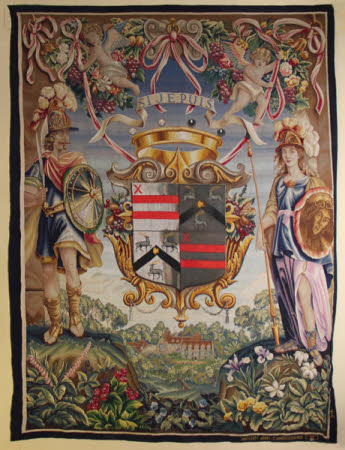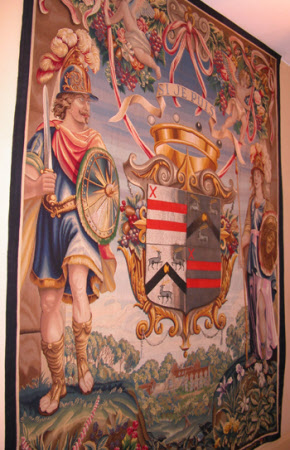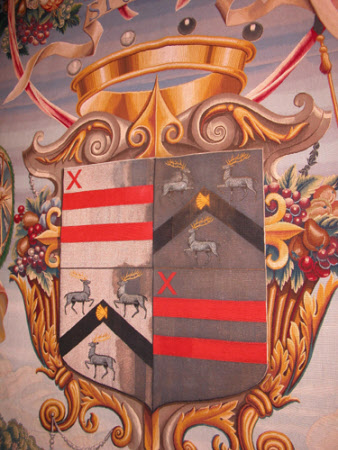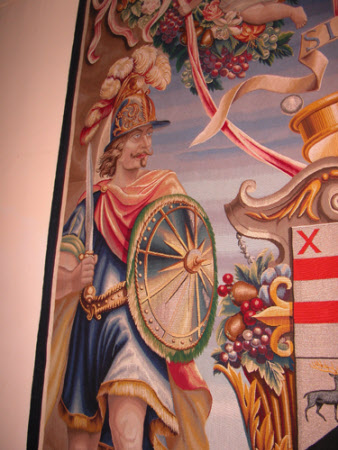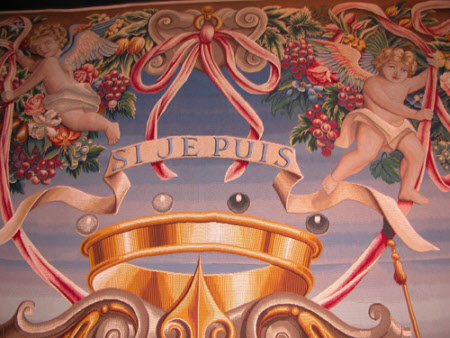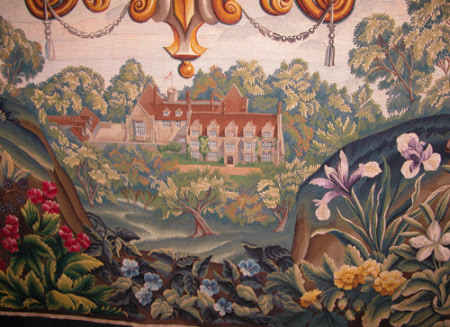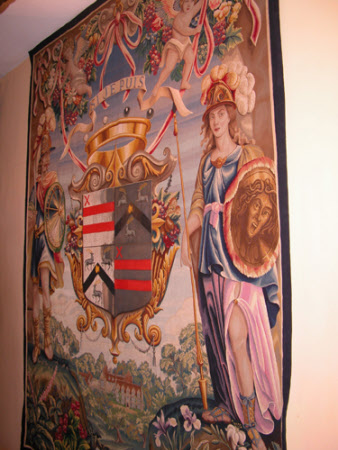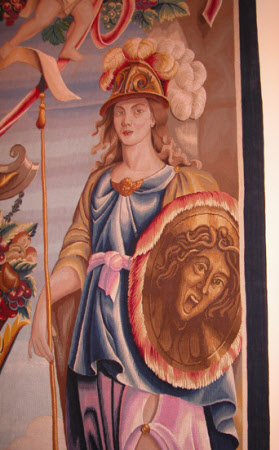The Arms of Huttleston Rogers Broughton, 1st Lord Fairhaven
Cambridge Tapestry Company
Category
Tapestries
Date
1939
Materials
Tapestry, wool, silk and metal thread, 7 warps per cm
Measurements
2.76 m (H); 2.08 m (W)
Place of origin
Cambridge
Order this imageCollection
Anglesey Abbey, Cambridgeshire
NT 516781
Summary
Tapestry, wool, silk and metal thread, 7 warps per cm, The Arms of Huttleston Rogers Broughton, 1st Lord Fairhaven, Cambridge Tapestry Company, 1939. A large coat of arms fills the centre of the tapestry, supported by pink ribbons held by two putti who hover among swags of fruit at the top of the tapestry. The arms are surmounted by a Baron's coronet and a bannaret with a motto, and set on a decorative surround imitating metalwork with bunches of fruit at each side. Either side of the arms are figures of Mars and Minerva, standing on grassy hillocks at the bottom of the tapestry. Colourful flowers grow along the lower edge, and below the arms there is a view of Anglesey Abbey. The tapestry is signed with the 'CT' monogram of the Cambridge tapestry company and dated 1939 at the bottom of the right hand galloon, and inscribed 'ANGLESEY ABBEY · CAMBRIDGESHIRE' with another signature on the lower galloon.
Full description
The design of 'The Arms of Lord Fairhaven' is inspired by a seventeenth-century tapestry in the collection at Anglesey Abbey, a 'Portière with the Arms of Don Luis de Benavides, Marqués de Caracena', woven in around 1660 (no. 516754). The structure of the earlier tapestry has been followed closely, the only major changes being to the coat of arms, the addition of a view of Anglesey Abbey (which replaces a view of an unidentified town in the earlier tapestry), and the omission of the narrow border. A story is attached to the tapestry that the faces of the two putti supporting the coat of arms represent two of the young women who wove the tapestry. Clifford Barber, who designed the 'Arms of Lord Fairhaven' as well as the earlier 'Anglesey Abbey' tapestry, enrolled at the Cambridge Tapestry Works as a young man having trained at the Cambridge School of Art. He was the first locally-trained designer to join the workshop's drawing office, which would eventually house up to 40 men (CWN 1988). The Cambridge Tapestry Company began as a cottage industry in Ickleford, Hertforshire, where a Mr and Mrs Witter taught needlework and metalworking to local children. Their business expanded and in 1904 they officially established themselves as Ickleford Industries. Some time between 1908 and 1911 the pair became friends with M. Gonnet, head of the Gobelins tapestry workshop in Paris, and he sent two of his weavers to England to teach the art of tapestry weaving and restoration (http://www.thewittercollection.co.uk/). The growing trade in historic tapestries led to rapid expansion and in 1916 premises were bought at no. 15 Thompson's Lane, and the Cambridge Tapestry Company was officially established. During the 1920s the restoration business boomed, and there were as many as eighty workers, mainly young women, in each of the two Cambridge workrooms. One of the projects undertaken was the restoration of an early sixteenth-century tapestry of the 'Life of the Virgin' that was subsequently bought by William Burrell and is now in the Burrell Collection. The 'Anglesey Abbey' tapestry, commissioned by Lord Fairhaven in 1934, was the first to be woven at the Cambridge Workshop after a new design. During weaving Queen Mary (then Duchess of York) visited the workshop to see the work in progress, and this led to the commission, in 1935, of a tapestry of Windsor Castle, also designed by Clifford Barber, to commemorate the Silver Jubilee of that year. ('The Times', 9 January 1934; 'The Times', 27 July 1936; Barber 1936a, Barber 1936b, Barber 1937). During the 1930s the workshop declined due to loss of trade and, especially in the later 1930s, the difficulty in obtaining raw materials. In 1939 the Cambridge Tapestry Company ceased to exist and much of the company's stock was sold to the Royal School of Needlework. Lord Fairhaven and Professor Wace tried to keep the weavers together and re-named the workshop the Tapestry Company under Arthur Baldry as Director (Cheney 1988). Fairhaven's decision to commission 'The Arms of Lord Fairhaven' in 1939 must have been in part motivated by his desire to keep the workshop going. A series of letters now held at Anglesey Abbey show that Lord Fairhaven had a controlling interest in the company in its last years, and company accounts were submitted to him from 1940 onwards. Business was officially stopped in 1941 with the exception of jobs already in hand, and in March 1943 the premises at Thompson's Lane were vacated. Although the Company is only known to have made three large-scale tapestries after new designs – the two at Anglesey Abbey and the Royal Jubilee tapestry – a number of pieces of needlework are recorded and many still survive. A double-sided two-leaf screen in the National Trust's collection at Lanhydrock is one of these (no. 883242), its design of a medieval hunt in woodland matching a cartoon now in the possession of descendants of the Witter family (illustrated at http://www.thewittercollection.co.uk). (Helen Wyld, 2012)
Provenance
Commissioned in 1939 by Huttleston Rogers Broughton, 1st Lord Fairhaven (1896-1966) for Anglesey Abbey; bequeathed to the National Trust by Lord Fairhaven with the house and the rest of the contents.
Credit line
Anglesey Abbey, The Fairhaven Collection (The National Trust)
Marks and inscriptions
At bottom of right hand galloon: the initials 'CT' and the date '1939' On banneret above coat of arms: SI JE PUIS On lower galloon: ANGLESEY ABBEY · CAMBRIDGESHIRE followed by the initials CC either side of the shield of the city of Cambridge
Makers and roles
Cambridge Tapestry Company , workshop Clifford Barber (fl.1930s), designer
References
CWN 1988: 'Peerless skills faded away during the war', Cambridge Weekly News, 28 July 1988 Cheney 1988: Judy Cheney, 'The Cambridge Tapestry Company', Cambridge Guild of Weavers Spinners and Dyers Newsletter, 14 January 1988 (n.p.) Cheney 1987: Judy Cheney, 'The Cambridge Tapestry Company', Cambridge Guild of Weavers Spinners and Dyers Newsletter, 13 August 1987 (n.p.) Barber 1937: Clifford Barber, 'A Little Known Cambridge Industry', The Cam, May 1937, pp. 136-8 Barber 1936b: Clifford Barber, 'Modern Tapestry', The Master Key, September 1936, pp. 243-6 Barber 1936a: Clifford Barber, 'Pageantry of Kings Emblazoned in Tapestry', The Master Key, August 1936, pp. 179-80 Wyld 2013: Helen Wyld, ‘Unusual Skill and Enterprise: Anglesey Abbey and the Cambridge Tapestry Company’, National Trust Arts, Buildings and Collections Bulletin, May 2013, pp. 1-3
